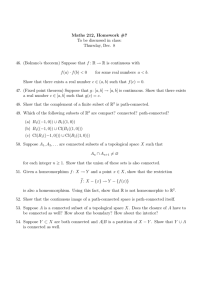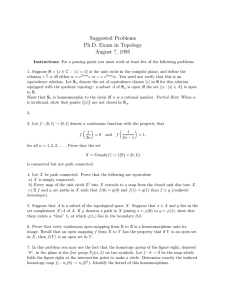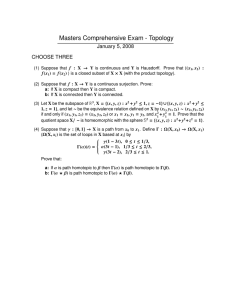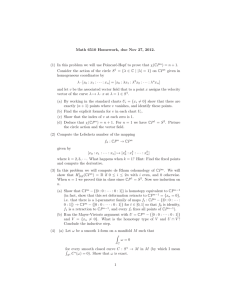Solutions to Problem Set 9 December 13, 2015
advertisement
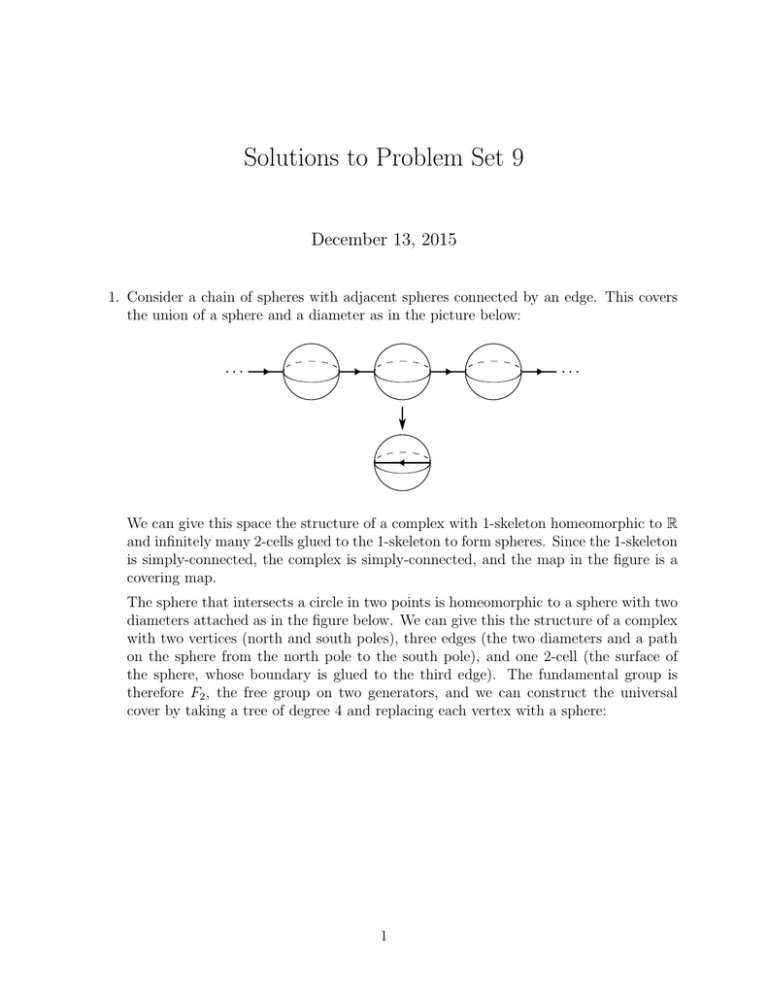
Solutions to Problem Set 9 December 13, 2015 1. Consider a chain of spheres with adjacent spheres connected by an edge. This covers the union of a sphere and a diameter as in the picture below: We can give this space the structure of a complex with 1-skeleton homeomorphic to R and infinitely many 2-cells glued to the 1-skeleton to form spheres. Since the 1-skeleton is simply-connected, the complex is simply-connected, and the map in the figure is a covering map. The sphere that intersects a circle in two points is homeomorphic to a sphere with two diameters attached as in the figure below. We can give this the structure of a complex with two vertices (north and south poles), three edges (the two diameters and a path on the sphere from the north pole to the south pole), and one 2-cell (the surface of the sphere, whose boundary is glued to the third edge). The fundamental group is therefore F2 , the free group on two generators, and we can construct the universal cover by taking a tree of degree 4 and replacing each vertex with a sphere: 1 This is simply-connected (indeed, it is homeomorphic to a complex whose 1-skeleton is a tree), and the map shown is a covering map. 2. Let x̃0 ∈ X̃ be such that p(x̃0 ) = x0 . Let H = p∗ π1 (X̃, x̃0 ). Suppose that [γ] ∈ π1 (X, x0 ) is such that f∗ (π1 (Y, y0 )) ⊂ [γ]−1 H[γ]. We claim that f lifts, that is, there is a map f˜: Y → X̃ such that p ◦ f˜ = f . Let γ̃ be the lift of γ such that γ̃(0) = x̃0 and let x̃00 = γ̃(1). Since γ is a loop, we have p(x̃00 ) = x0 . Furthermore, the change of basepoint map bγ ([λ]) = [γ̃¯ · λ · γ̃] is an isomorphism from π1 (X̃, x̃0 ) to π1 (X̃, x̃00 ) and p∗ (bγ ([λ])) = [γ]−1 p∗ [λ][γ]. Therefore, p∗ π1 (X̃, x̃00 ) = p∗ bγ (π1 (X̃, x̃00 )) = [γ]−1 H[γ], and f∗ (π1 (Y, y0 )) ⊂ p∗ π1 (X̃, x̃00 ). By the lifting criterion, f lifts to a map f˜: (Y, y0 ) → (X̃, x̃00 ). On the other hand, suppose that f lifts to a map f˜: (Y, y0 ) → (X̃, f (y0 )). Then f∗ (π1 (Y, y0 )) ⊂ p∗ π1 (X̃, f (x̃0 )). But changing the basepoint of a cover changes the induced subgroup by conjugation, so there is a [γ] ∈ π1 (X, x0 ) such that f∗ (π1 (Y, y0 )) ⊂ p∗ π1 (X̃, f (x̃0 )) = [γ]−1 H[γ], as desired. 2 3. First, we claim that each point in p−1 (U ) is contained in a homeomorphic copy of U . Suppose ũ ∈ p−1 (U ) and let u = p(ũ). By the lifting criterion, the inclusion i : (U, u) ,→ (X, u) lifts to a map ĩ : (U, u) ,→ (X̃, ũ), and since i is injective, so is ĩ. If Ũ = ĩ(U ), then ĩ is a bijection from U to Ũ . Since ĩ lifts i, we have p ◦ ĩ = idU , so p|Ũ is a continuous inverse to ĩ and thus ĩ is a homeomorphism. Since U is path-connected, so is Ũ ; we claim that Ũ is a path component of p−1 (U ). Suppose that γ̃ is a path from ũ to ṽ such that p(γ̃) ⊂ U . Let γ̃ 0 = i ◦ p ◦ γ̃. This is a path in Ũ that is based at ũ and satisfies p ◦ γ̃ 0 = p ◦ i ◦ p ◦ γ̃ = p ◦ γ̃. Therefore γ̃ and γ̃ 0 are lifts of the same path that are based at the same point. Thus γ̃ = γ̃ 0 , so ṽ = γ̃ 0 (1) ∈ Ũ . Therefore, all of the copies of U are disjoint. Finally, we claim that they are all open subsets of X̃; if ṽ ∈ Ũ , then there is an evenly covered path-connected neighborhood V ⊂ U ⊂ X such that p(ṽ) ∈ V . Let Ṽ be the copy of V that contains ṽ. Then Ṽ is path-connected, so it is contained in Ũ , and Ṽ is open. Thus Ũ is open. Now, suppose that p : Z → Y and q : Y → X are covering maps and that X is pathconnected, locally path-connected, and semi-locally simply-connected. If x ∈ X, let U be a path-connected neighborhood of x such that every loop in U is null-homotopic in X. Then p−1 (U ) ⊂ Y consists of disjoint open copies of U . Each of these is pathconnected. If Ũ is such a copy, let ĩ : Ũ → Y be the inclusion map. Then p∗ ĩ∗ π1 (Ũ ) is trivial and p∗ is injective, so ĩ∗ π1 (Ũ ) is trivial. It follows that each Ũ satsifies the conditions of the problem, so q −1 (Ũ ) consists of disjoint open copies of U , and thus q −1 (p−1 (Ũ )) consists of disjoint open copies of U as desired. 4. Suppose that f : X → S 1 and that π1 (X) is finite. Then the map f∗ : π1 (X) → Z is trivial, so there is a lift f˜: X → R. Any map to R is homotopic to a constant map via a straight-line homotopy, so there is a homotopy h : X × [0, 1] → R that starts at f˜ and ends at the constant map. Then p ◦ h is a homotopy that starts at f and ends at the constant map, so f is homotopic to a constant map. 3
